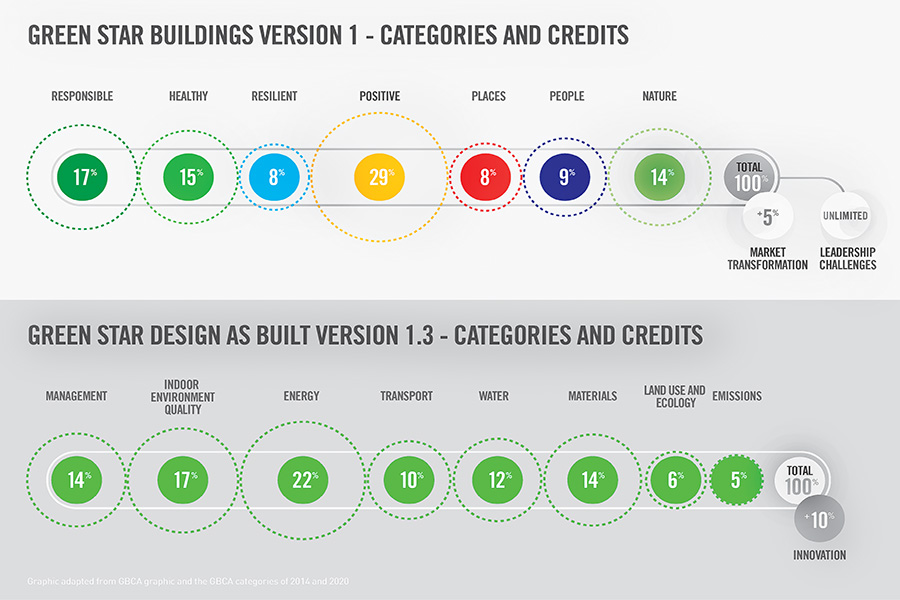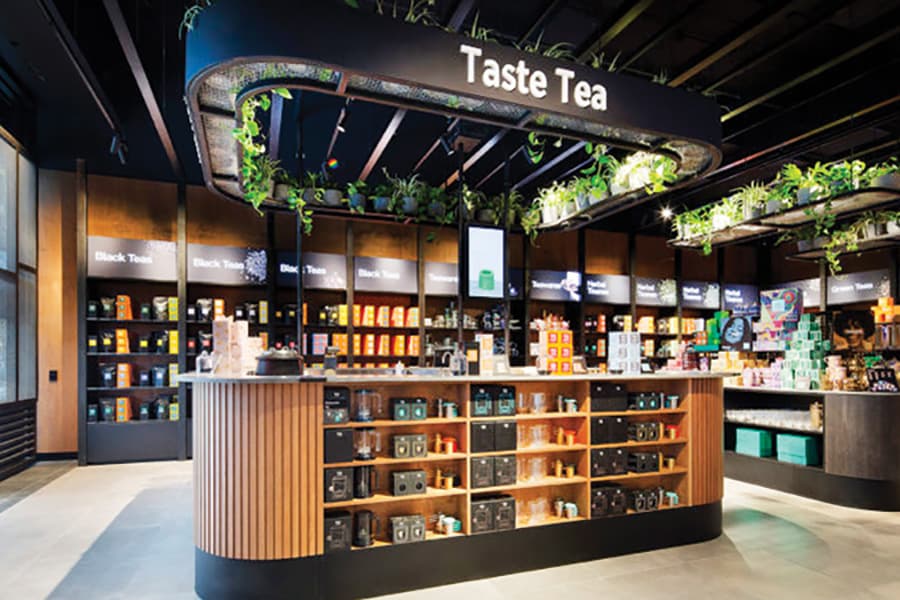This article co-authored by Claire Bowles Sustainability Lead, i2C Architects & Chris Buntine, Sustainability Manager, Northrop Consulting Engineers was first published in SCN Vol. 39 No. 1, 2021
In October last year, the new Green Star Buildings rating tool was released; it will replace the legacy tool beginning this coming December. The new tool shouldn’t be seen as a way to ‘get credit points’, rather, it should be embraced as a project’s ‘North Star’, guiding design and establishing the sustainability story.
The year 2020 was certainly strange for many but one of the positive outcomes was the release of the new Green Star Buildings ratings tool in October. Having been involved in the process in the expert reference panels for Nature and Place, it was a pleasure to see the result coming out with a heightened appetite to transform and lift the expectations for clients in the built environment sector. When we look at this tool in the context of retail what do these new changes mean and what impact may they have on stores of the future here in Australia? What does the tool enable and what is the tool failing to achieve for our retail assets?
Green Star has long been the ‘go-to’ certification standard for commercial and retail buildings with buildings striving for 4, 5 and 6-Star ratings. The two rating options have been Green Star Design and As-Built for new buildings and major refurbishments, and Green Star Performance for in-use operations. Green Star tools have accelerated the shift to sustainable buildings having notched up more than 3,000 project certifications with 40% of retail space in Australia being Green Star certified and 1.3 million people visiting a Green Star-rated shopping centre each day.
Changes in consumer buying patterns and an increased desire for retail stores to become places for community health and resilience has driven the increasing penetration of Green Star certification into the retail market.
Stores such as T2, Country Road and Kathmandu have set precedents and are leading the way in terms of responding to what their customers are asking for – and Green Star has been the tool that has enabled them to do so.
We have also recently seen a rise in the uptake of Green Star within the back-of-house supply chain in retail. Industrial built assets – industrial buildings such as warehouses and cold-store facilities – have been looking to Green Star for their certification to meet their investor requirements and demonstrate their corporate sustainability commitments. The future proofing of these industrial assets for climate change and low carbon economies is vital and Green Star offers a pathway for this to happen.

With its last major revision completed in 2014, Green Star Design and As-Built was beginning to fall short as a benchmark for Australian excellence and world leadership. We were starting to see industry players racing ahead, innovating and lifting the bar on sustainability. Case in point is the Burwood Brickworks project in Melbourne where Frasers Property opted not only to target a 6-Star Green Star rating but also the Living Building Challenge, widely regarded as the most ambitious sustainability rating in the world. But the new Green Star Buildings tool is a complete refresh and represents a serious step up in ambition for any project targeting a rating for new buildings and refurbishments. Currently optional, Green Star Buildings will replace the legacy tool beginning in December 2021.
What has not changed in Green Star Buildings is certification based on design and construction, as opposed to in-use performance. We know from significant research that the complex, bespoke nature of buildings and variability in user behaviour means that in-use performance often does not live up to the design intent – a phenomenon known as the performance gap. It is for this reason that tools like Living Building Challenge, WELL and NABERS are based on actual, measured performance. We have, however, seen a significant broadening in categories to include areas such as people, place and nature, and a shift towards recognising the importance of place and people-based design and striving for targets that encourage biophilic design and actions for biodiversity.
So how much of a stretch is the new Green Star Buildings tool?
Assuming a target of a 6-Star Green Star rating, let us consider the requirements that impact the building’s carbon footprint. In the legacy Green Star Design and As-Built tool, the only requirement was for an energy efficient building, exceeding the building code by about 20%, depending on the compliance pathway. Under Green Star Buildings it will be a whole new ball game. There will be an expanded set of requirements within what is called the Net Zero Carbon in Operations, meaning that buildings must be fossil fuel free, renewably powered, highly efficient (20% beyond code) with lower upfront emissions and refrigerant global warming impacts eliminated or offset. And here is the kicker. In 2023, this requirement applies to all 5-Star Green Star ratings and in 2026 to all buildings seeking certification. While this might seem challenging, these requirements have been developed to be consistent with the Paris Agreement and climate action being taken by government and industry.
Whether Green Star Buildings represent a compelling business case remains to be seen. Achieving a 5 or 6-Star Green Star rating for a retail development represents approximately 1.7% of a typical project budget. It would be reasonable to assume that Green Star Buildings will have a significantly higher capital cost, but that this will reduce eventually as leading design practices become mainstream over time. It is true, however, that a Green Star rated building will cost significantly less to operate, present a more attractive tenancy, raise property values and generate positive visibility in the market, all of which contribute to the business case.
While Green Star Buildings will accelerate the shift to sustainable buildings, it can also be a double-edged sword. All too often, the process of targeting a rating can degrade into a point chasing exercise, divorced from a more thoughtful, collaborative and holistic sustainable design process. Getting the most value from a Green Star rating means using the tool appropriately and recognising that it is not a design tool nor a design process. For example, don’t kick-off sustainable design by walking the project team through each Green Star credit. Instead spend time understanding the value drivers for the project and how this translates into a vision and set of principles for sustainability. This becomes the project’s North Star, guiding design and establishing the sustainability story that inspires and engages the team and your community. Then establish an integrated design process that brings the project team together to encourage whole systems thinking and facilitate design collaboration. Use Green Star as a benchmarking resource and a means of driving accountability and verifying outcomes. Keep in mind that Green Star isn’t the only game in town and that tools like Leadership in Energy and Environmental Design (LEED), Living Building Challenge, NABERS, WELL and Climate Active could be used as an alternative or in conjunction with Green Star.
While this new tool is a step in the right direction, it is essential to recognise that there will be a steep learning curve and it is not a golden bullet for the retail industry.
A Green Star scorecard cannot continue to be the sustainable design process for buildings. For Green Star to have the intended transformational effects across the sector there needs to be a robust design process that sets out the sustainability priorities and principles for the project early in the briefing stage. It’s then a case of matching the tool that best fits with the project vision to provide the metrics for certification. The vision and principles for the project need to drive the design decisions, not the scorecard. If we can get that right and lead projects with sustainability at the core of the project strategy then change will happen.
One of the biggest opportunities for retail is a mindset change from seeing sustainability as a compliance cost, to creating business value. By setting this up from the very start and bringing the whole team along for the journey, we will be in a position to support sustainability as a critical long-term investment.
About the Authors
Chris Buntine is a Sustainability Manager at Northrop Consulting Engineers where he is responsible for delivering leading sustainability consulting services to a wide range of clients in Australia. He is dedicated to unlocking the potential for positive, value-driven sustainability outcomes on building, precinct and infrastructure projects. Starting out as a Civil engineer, Chris has Master degrees in Urban Planning, Business and Building Science, with a career that spans time in the U.S. and Australia. Chris is advocate for regenerative development and accelerating the shift to a carbon neutrality and climate resilient built environment. He is a coordinator of Engineers Declare a Climate and Biodiversity Emergency.
Claire Bowles joined i2C as their Sustainability Lead in 2018 to establish their core sustainability principles and goals. As a Regenerative practionner and accredited Green Star professional, Claire works closely with clients on their purposeful objectives for projects to achieve positive outcomes. Her Master’s degree in Strategic Project Management, experience as a construction improvement consultant in the UK gives Claire a broad base from which to bring stakeholders together and drive innovative thinking around regenerative and living systems design. She is passionate about approaching our built environment as an opportunity to create positive buildings and places that act as educational, inspiring acupuncture points for a new way of living, being and working. She is a firm believer that we can all contribute and have a positive impact on our communities, society and wider natural environments.





















